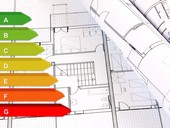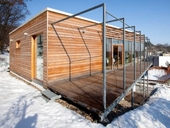In this article, the author deals with the vent rotating heads, which are widely available as replacements for roof fans in the ventilation systems of sanitary units. Measurements that have been carried out will show what may be the realistic expectations of users who install these ventilation systems.
Archiv článků od 4.1.2010 do 29.11.2010
Heat released in biomass combustion can be effectively stored in an accumulation tank. Traditionally, water is used as a main heat transfer medium. However, progressive materials, such as Phase Change Materials (PCM´s), offer better heat storage capacities. The materials work on principle of sensible and latent heat accumulation / release. While the phase change material takes up the heat, during the reversed process the stored latent heat is released. In our work the following materials were studied: paraffinic waxes, fatty acids and their eutectic mixtures. These materials provide higher heat potential per unit volume. Therefore, PCM´s can prolong the lifetime of biomass-fired systems.
A revised version of the directive was issued in 2010 under the title 2010/31/EU. In part, it is a modification of the original. In it, there are have been defined new administrative tools to increase the energy performance of buildings - among others, it includes the concept of "building with almost 0 energy consumption".
I am very often asked what issues are still being addressed at the seminars on passive houses, because they have all been already resolved and these buildings are pretty common abroad. The truth is that in other countries the construction of low energy buildings started in the 1990's. However, their ecological, technical and energetic aspects are still evolving. The building structure itself is improving, as well as the insulation systems, heating, ventilation and new building materials and technologies are becoming more sophisticated. It has all gradually come to houses that consume almost no energy. Let's have a look at some of the aspects of the developments.
The following contributions, which deal with this problematic, consider the impact of high heat resistance of the walling on the thermal comfort and the design of heating ventilations systems, which are still perceived, as it is the case in buildings with classical walling, therefore, to have lower thermal resistance. For instructions to formulate the effect of walling on the thermal comfort and technical equipment, a general comparison of both the following cases is made, which is simply called building with high thermal resistance of external walls for a low-energy house, and a building with classical walling parameters (e.g. housing estate from the past) as a standard house. The articles are not of exact technical nature and deal with regularly updated dependencies and sometimes refer to previously applicable legal provisions.
The problematic of energy savings should not be limited only to thermal insulation and occasional use of alternative energy sources. The energy used not only for heating, but also for ventilation and air conditioning. Significantly affect the consumption requirements, deciding which areas will be heated and at what temperatures. Energy is needed to produce construction materials, their transportation and eventual waste handling. The lifespan of the proposed construction and the complexity of its liquidation should be one of the essential criteria when deciding on contemplated modifications. It is necessary to consider buildings as architectural heritage.
The viscosity is a physical value that determines the ratio between tangential tension and speed change depending on distance of neighboring layers at flow of real liquids. This tangential tension causes that the faster layer accelerates the slower layer and vice versa. Greater viscosity means greater deceleration of liquid’s movement or objects in the liquid. This is what theory says. What does it mean in practice?
The article deals with the issue of unwanted condensation of water vapour on internal surface of building structures. Building and physical conditions of surface condensation of water vapour is analysed. It discusses possibilities of technical solutions leading to elimination of the mentioned negative phenomenon – change of use, adjustment of peripheral structures, reaching the required parameters of internal air by natural ventilation or through air-conditioning.
This article extends the article "Ventilation with heat recovery in flat - yes or no?" and it is concerning with pressure forced ventilation with electric heating coil. This unit includes ventilator, which sucks the external air in from the façade. The electric heating coil with the power of 250 W preheats the external air which is distributed to the rooms with the air distribution system. Nowadays there are a lot of these units on the market that differ in air volume and heating power. The aim of this article is to investigate whether this unit ensures good air quality and what are the costs. The paper was made within the framework of the R&D project performed by the experts in the company EkoWATT, Czech Republic. R&D project VAV-SP-3g5-221-07 is supported by the Ministry of Environment.
Today we have detailed, scientifically based evidence tested in practice, revealing that the construction of new buildings and the renovation of old ones can reduce their energy consumption to values lower than 10% of the current average. This ability of architects, planners, construction workers and companies has arrived just in time to help us avoid the worst consequences of climate change.
Today, many air handling units are supplied with integrated control system. Integration of those controls into a building management system may bring along lots of questions in the design and specification phase. If the parties involved are able to exchange relevant information in time, they avoid delays and problems in supplies and commissioning. AHUs and other components with integrated controls are changing the role of the control system suppliers who have to become system integrators. However, the mechanical part suppliers will have to increase their know-how on communicative controls.
The author deals in his article with possibilities of a quality control with elements of intelligence. He passes on the readers by way of very precise, factual and interesting form his practical experiences from the area of control systems and draws attention to frequent mistakes that occur during the designing and implementation phases.
As of the 1st Octo 2009 is in force in the Slovak Republic the decree 311/2009 Z.z., which lays down the details for he calculation of the energy performance of buildings and the contents of the energy certificate. It is a binding document resulting from the law 555/2005Z.z., in which the Directive 2002/91/EC on the energy performance of buildings is implemented.
Nowadays the ventilation and indoor air quality is a main issue because the quality of the interior environment is in focus of occupants. The main reason of interests is that the new windows are leak tight and natural infiltration is low as well as IAQ. Without the ventilation system the CO2 concentration is above the healthy standard (1200ppm). To achieve this CO2 level demands a lot of energy and to supply low temperature from outside directly cases also unsatisfactory thermal comfort. The ventilation with heat recovery is one of the possible solutions for energy savings. In article the deep economyy&energy calculation was performed by using building performance simulation tool IES<VE> and suggestion for manufacture was given. The paper was made within the framework of the R&D project performed by the experts in the company EkoWATT, Czech Republic. R&D project VAV-SP-3g5-221-07 is supported by the Ministry of Environment.
From the phase of architectural studies, the building process goes through steady changes. The expert "forecast" of the thermal behaviour of these buildings will almost always be hampered by the lack of input data. However, even in such cases there are ways to provide valuable information about future features of the project. The information doesn't need to be always accurate. For example, if we asked if the building will be low-energy, it would be enough to know, among other things, if the resulting heat needed for heating will not exceed a certain threshold. We are able to identify this already at the stage where we have a clear idea about, for example, the properties of windows or the exact shape of the building. In this case, it is appropriate to extend the standard calculation procedures to be able to describe not only one chosen object, but a number of variations that may occur depending on what the we know about the building at a given moment. This presents a method for design and estimation of thermal-technical properties of family houses with very low energy requirements. The method uses the creating of variants with the Monte Carlo simulation applied to the parametric model house (monthly calculation according to EN ISO 13790 and 730329 DESERT). The results show the influence of individual characteristics of the building on the heat balance and makes it possible to optimise the overall building.
The following contributions, which deal with this problematic, consider the impact of high heat resistance of the walling on the thermal comfort and the design of heating ventilations systems, which are still perceived, as it is the case in buildings with classical walling, therefore, to have lower thermal resistance. For instructions to formulate the effect of walling on the thermal comfort and technical equipment, a general comparison of both the following cases is made, which is simply called building with high thermal resistance of external walls for a low-energy house, and a building with classical walling parameters (e.g. housing estate from the past) as a standard house. The articles are not of exact technical nature and deal with regularly updated dependencies and sometimes refer to previously applicable legal provisions.
The author draws attention to the deterioration of the quality of indoor environments in flats where the original windows have been replaced by modern, tight windows, which although improve the flat's energy balance, they also limit the possibilities for ventilation. Moisture that has not been ventilated accumulates in the flat, which leads to mould growth, and in the case of gas appliances, there are also exhaust gases, which are are toxic substances that lead the health problems, intoxications and even death. In the Czech legislation there aren't sufficient basis for an unambiguous determination of the requirements for the quality of the indoor environment of flats, including the requirements for their security, i.e. ventilation. The information can be found in selected European Standards, the author cites ČSN EN 15251.
zpět na aktuální články

